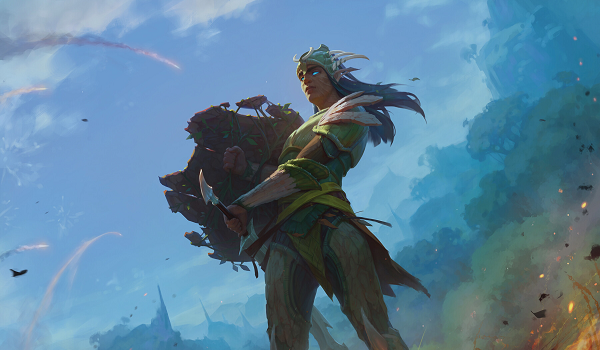Are you a Quiet Speculation member?
If not, now is a perfect time to join up! Our powerful tools, breaking-news analysis, and exclusive Discord channel will make sure you stay up to date and ahead of the curve.
Citanul Stalwart has completely warped my experience in The Brothers' War Limited, earning me many trophies in the process. It goes disproportionately late, and as a result I find myself in this deck a disproportionate amount of the time. Players are not evaluating this card correctly, so even when a clear lane presents itself, a late Stalwart can present interesting deck building opportunities, which can allow us to draft more consistently and provide access to more powerful tools. This week I want to discuss how to properly draft and build Citanul Stalwart decks, as well as explain why this card must be on our radar.
Warping the Draft, Warping the Format
GIH WR% doesn't tell the whole story with this turn one enabler. In decks that can utilize Stalwart, it can feel like having access to multiple Birds of Paradise. This isn't a luxury many limited decks enjoy, but it could be.
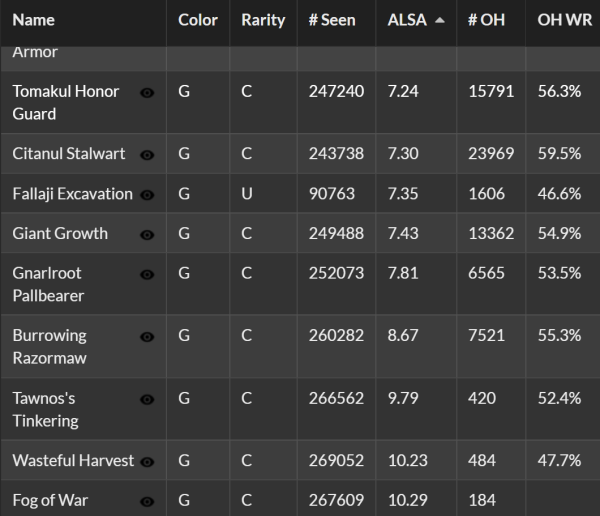
In the above table, ALSA is a stat that tracks, on average, when a card is last seen in a pack. OH WR tells us the win rate of a card when it is in our opening hand. Citanul Stalwart is seen about as late as green's least playable cards, but it boasts a high win rate when it is in our opening hand (it has the highest OH WR amongst all green commons, and the fourth highest OH WR amongst all green cards). Yet on average, we can have this card towards the end of a pack. Speculating on late Citanul Stalwarts is essential to maximizing wins in this format.
Taking this card late allows us to gamble low-equity picks on high-equity upside. What upside is that? Having access to the highest-power cards available, in all five colors.
As we navigate the draft, there's strong reason to select Citanul Stalwart early; however, if we're seeing it late, we need to at least be considering the option.
Building Birds
Comparing Citanul Stalwart to the most Bolt-able creature in MTG history might be a slight stretch. The biggest difference is that we need to build around our favorite Elf Druid Soldier with permanents that allow it to generate mana early and often. We're willing to spend a little bit of mana now to ramp and fix for later, and these cards all do that without requiring a second color of mana.
On Color Enablers
These cards do a nice job replacing themselves with value while still being early enablers for our Stalwart. We're not willing to use two cards to build a mana source, but if we can be reimbursed for our troubles, the payoff gets a lot closer to being free.
Tapping Howling Mine deactivates it for our opponent's turn. With Citanul Stalwart, we can deny our opponent a card every turn and generate mana when we need it. This felt like a pretty powerful turn two:
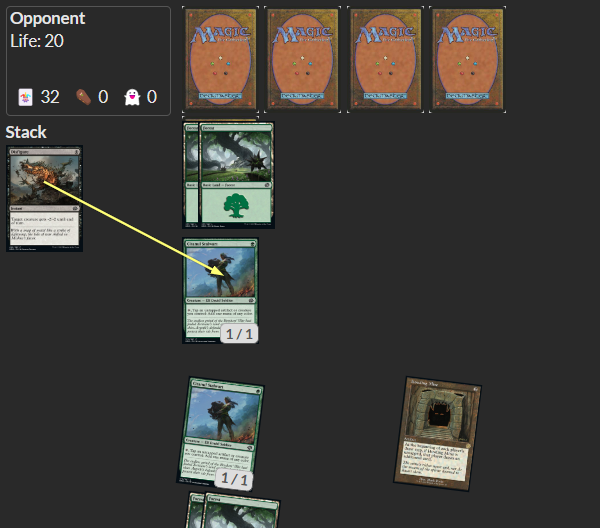
You've heard of Bolt the Bird; now it's time to Disfigure this figure.
Building Manabases
While Stalwart has an enormous impact on what our deck can do, it represents very little impact as a game piece on the board. Its 1/1 stature means it won't impact racing or combat in a significant way, and as a result, we can't really count it as an action spell. We should count it as a land when analyzing our land-spell ratio.
However, we can't rely on it if we can't cast it. As a result, my mana bases always have nine or ten green sources. Because it helps support our low land count, Evolving Wilds is something we should prioritize. It boosts low counts of other sources that, in conjunction with the Citanul Stalwart itself, will help smooth over our ambitious, multi-color agenda. Remember that our cantrip artifacts and Blanchwood Prowler also fortify our land count.
Because we have access to multiple five-color sources, we can afford to be judicious when including basic lands to accommodate smaller splashes. This list only has thirteen lands, but uses all five colors.
Even with an Evolving Wilds, we don't want to sacrifice card slots to random basics. Because we're not playing multiple basics, the color of our splashes are irrelevant. We might have three cards that need a black splash or three cards splashing into three separate colors. When this is the case, Three-Color Stalwart decks are just as splashy as Five-Color Stalwart decks.
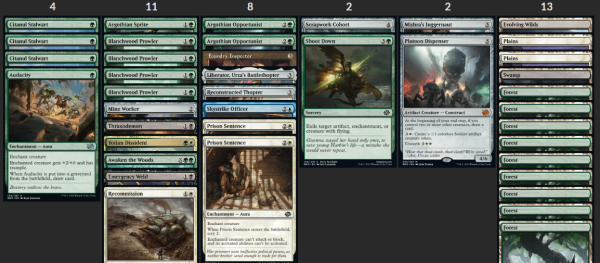
5 Color Stalwart (7-2)
While we have access to all colors, it makes sense to prioritize green cards, and a secondary color respectively. Just because we can splash five colors doesn't mean we should ignore the tenets of good deck-building.
The Cards We Want
As to be expected, we want copies of Citanul Stalwart in our Multi-Color Stalwart decks. In personal experience, three copies feels reliable, but the more the merrier is a sound policy. Remember, the 1/1s shouldn't water down our decks, because we evaporate a land from our base with each addition. (Staying around 9-10 green sources remains crucial for this math to work.)
Energy Refractor is a reasonable stand-in for the third, but we'd rather pair it with our three Stalwarts, giving us four multi-colored sources (Stalwart is far better). Springleaf Drum is an option, but we need to be cognizant of the cards we're using to activate it.
Once this mana base is unlocked, we want strong cards that can help us recover. This deck is a great home for all of the best commons in the format. The unearth creatures, especially Scrapwork Cohort, are all excellent here. They are easy to cast because of their colorless frontside, and Stalwart unlocks the backside. Cohort helps stabilize our boards or help pressure opponents. Argothian Opportunist is another premium common for this deck. It's a good resource for combat and a free permanent for Stalwart.
Additionally, we are usually looking to gum up the board, and Boulderbranch Golem is a flexible tool that helps us get to our late-game while still being a potential win condition on its own. The good removal spells are also good here. We have access to splash the more expensive ones, as well. While those are some of the most desired ingredients, the recipe is always going to be a brew.
Unlocking Every Possibility
We want cards to help activate our Citanul Stalwart, and we want the good commons that are in our base color. After that, it gets more interesting.
A Citanul Stalwart manabase can account for whatever the draft is providing, as well as splash for other strong cards. This deck looked to be an UB Control pile. When Citanul Stalwart showed up, our plan became a lot more dangerous. It easily splashed an Urza, Prince of Kroog, and as the black cards dried up, the Stalwart enabled a better plan.
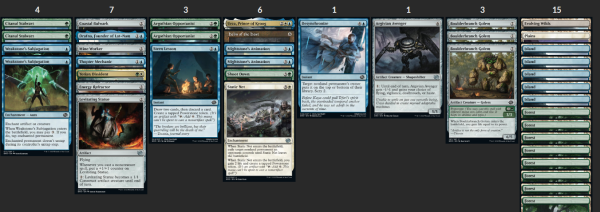
Citanul Urza 7-2
In another draft, the BR Sacrifice deck looked like a real option. However, an early Howling Mine and a pick eight Citanul Stalwart offered another path. Two Stalwarts, two Energy Refractors, and a single Evolving Wilds made reusable by Perennial Behemoth facilitated a crazy concoction that used Mishra, Tamer of Mak Fawa to launch an unearthed Rust Goliath at opponents. Three copies of Scrapwork Cohort and a lot of Penregon Strongbull activations proved to be a capable endgame.
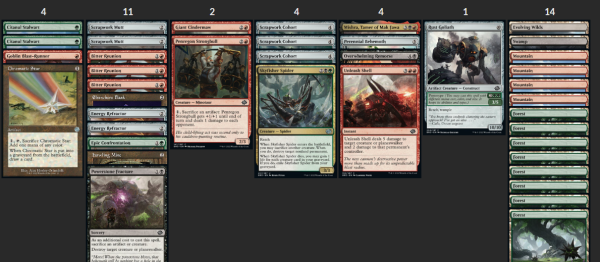
Rusty Slingshot 6-3
In short, Stalwart decks can absorb almost any archetype. However, the extra colors allow access to unique and powerful variations of those archetypes. We should be on the lookout for signpost uncommons and off-color rares. This flexibility can lead to extremely powerful decks, regardless of what the draft sends our way.
To Stalwart or Not to Stalwart
Stalwart decks are not without drawbacks. They take on additional risk because they can be overly reliant on their namesake common. Assembling the requisite enablers can also reduce your aggression.
While drafting, when a deck is presenting itself to us, we can follow the clear path for as long as it is available. When we take a Citanul Stalwart, we're inevitably passing other cards that might be a better fit. The grass is not always greener on the other side. However, if it feels like a color is drying up, a late Stalwart offers us a second path. We don't have to take that path, but it can be a nice option.
Additionally, this deck needs multiple Stalwarts. We can't build around a one-of one-drop. If we first see the Stalwart in pack three, it's probably too late for us to realistically consider that option. If we see it late in pack two, the chances are also slim. Weighing the expected value of a speculative Stalwart is something we have to do on a pick-by-pick basis.
Citanul Stalwart is a huge piece of the format and it helps teach us a lot about deck building. Because the draft can enchant us with twists and break our hearts with turns, we need to think on our feet. Stalwart intensifies this. Between splashes, enablers, and powerful effects, we're hardly drafting on rails. We need to navigate our deck towards a plan, and while enough Stalwarts can facilitate anything, we want to make sure there's a coherent strategy on the other end of all their fixing.
When we draft BRO, we should keep our eyes open for this little soldier. It lets us do a lot of crazy things and if we build around him effectively, anything is possible. There will be times when a late Stalwart Citanul package doesn't come together. If we don't have a reason to want the extra colors than don't bother playing them. However, even if you leave them out of your deck, the pick provides you more autonomy in the draft itself.
Shine a Little Light
I've had the chance to build around this rare enchantment twice. I remember having the option between this and Obliterating Bolt. 17lands informed me that the red removal spell had a far better win rate. For science, I decided to test the build around.
While Tocasia's Welcome might not have a stellar GIH WR, when built around, it is extremely powerful. Commit to the power this card offers. In the two decks I used it in, it was a cantrip on a combined 87.5% of creatures. Both of those decks trophied.
Don't forget that this card triggers off the 1/1 that Scrapwork Cohort brings with it. It can also trigger on your opponent's turn with Ambush Paratrooper or the death of a Thopter Mechanic. One of my decks had five copies of Airlift Chaplain. They felt like Mulldrifters. Recommission, Emergency Weld, and unearth creatures generate absurd value with this enchantment in play.
I've seen opponents play this card against me and draw one or two cards over a long game. I thought I was dead when it hit the table. Turns out it didn't do anything. This is a card that has a way lower win rate than it deserves because people are not using it correctly. Welcome can go from unbeatable to unplayable. If we have the opportunity to commit to this card, we can make it a bomb. The instructions for this card are pretty clear. Get the cheap creatures, play the enchantment, and profit. Happy drafting!


